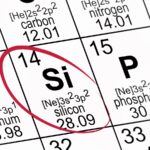
Silica nanoparticles

By the AVICENN team – Last modification November 2025
Silica nanoparticles
Multiple application sectors
Silica is used by industry in a wide variety of applications. Synthetic amorphous silicas (SAS) are used:
- as a moisture absorber in many products (including baby diapers and sanitary pads)1Two reports from Anses show this (without specifying the potential associated risks):
– Safety of baby diapers – Revised opinion of Anses, Collective expertise report, Anses, January 2019
–Safety of intimate protection products, Anses, December 2019: the study of the national registry of substances in the nanoparticulate state (r-nano) confirmed that “Silica in the nanoparticulate state is used for its “superabsorbent” properties. It is notably sold to actors involved in the manufacture of diapers and sanitary pads.”) - in food, as a food additive (E551) or “processing aid”:
- anti-caking agent in powdered foodstuffs (sugar, salt, flour, cocoa, and many dehydrated products such as soups, instant noodles, coffee, etc.)
- or viscosity modifier in sauces, soups, dressings, etc.
- we would absorb on average about 124 mg per day
- authorized, including in nano form for precisely defined uses (powdered foodstuffs, sugar, salt, seasoning, rice…) in 2009
- its safety is questionable.
- in cosmetic (lipsticks, shampoos, creams), as texturizing / fluidizing / opacifying agents and also, in toothpaste for example, as abrasive
- as reinforcing or thickening agents in various systems (elastomers, resins, paints, inks)
- in beer and wine as clarifying agents
- for non-stick coating2Cf. e.g. “Nanomaterials – Silica coating more slippery than Teflon”, Die Welt, March 2010 (like Teflon).
Presence of silica nanoparticles in France
According to the Ministry of Ecological Transition and Solidarity3Cf. bilan R-nano 2024, Ministry of Ecological Transition and Solidarity, February 2025, more than 100,000 tons of silicon dioxide (SiO2) nanos were registered in the r-nano database as imported and manufactured nano substances in France in 2023. This tonnage should be precised, as the quantities registered in the French R-nano database are below the quantities actually present on the French market, since many nanomaterials are not registered as such by industry.
Different nanoforms of silica are imported or produced in France, under different names: “silica gel”, “silicon dioxide”, “synthetic amorphous silica”, “salicylic acid – magnesium salt”, “silane”, “silicon dioxide”, “silicate”, “silane”, “dichlorodimethyl-“, “products of silica reaction”).
Almost all (if not all) of the primary silica particles used are nanomaterials:
- SAS used in the food industry (E551), according to the sectoral regulations (Inco and Novel food and the definition recommendation of the European Commission)4Cf:
– Tests conducted by Agir pour l’Environnement and published in June 2016 found 100% nanoparticle-sized silica in a Carrefour guacamole spice mix
– Inventory of Nanotechnology applications in the agricultural, feed and food sector, RIKILT & JRC, EFSA supporting publication, 2014
– Presence of nano-sized silica during in vitro digestion of foods containing silica as a food additive, Peters et al, ACS Nano, 6(3): 2441-2451, 2012
– Presence and risks of nanosilica in food products, Dekkers S et al, Nanotoxicology, 5(3), 393-405, 2011, the [nano] mention should appear in the list of ingredients after the term E551 or silica, but this labeling is not often implemented by manufacturers.
- SAS used in cosmetics. In July 2019, the European Scientific Committee on Consumer Safety (SCCS) published its final opinion on the solubility of synthetic amorphous silica (SAS)5Opinion on solubility of Synthetic Amorphous Silica (SAS), Scientific Committee on Consumer Safety (SCCS), June 20-21, 2019 (Corrigendum of December 6, 2019) according to which hydrophilic and hydrophobic SAS are to be considered as insoluble or very slightly soluble; under the Cosmetics Regulations 2009, these two SAS are therefore to be considered as nanomaterials and should be labeled with the word [nano].
Vigilance is required because there are significant risks associated with silica nanoparticles.
Any questions or comments? This information sheet compiled by AVICENN is intended to be completed and updated. Please feel free to contribute.
Other news on the topic
Our information sheets to go further
Upcoming Nano Agenda
- 8th Congress of Occupational Medicine and Health (CNMST 2026)
- Theme 5: Emerging pathologies and risks, Mr Henri Bastos (ANSES), Pr Lynda Bensefa-Colas (AP-HP), Dr Catherine Nisse (CHU Lille)
- Website: www.medecine-sante-travail.com
- 20th meeting of the “nano and health” dialogue committee
- Organizer: ANSES
- Training intended for occupational physicians, occupational risk prevention specialists (IPRP), company prevention specialists, prevention department staff from Carsat, Cramif and CGSS, institutional prevention specialists (Dreets, Dreal, MSA…).
- Organizer: French National institute of research and security (INRS)
- October 5 to 9, 2026
- Website: www.inrs.fr/…/formation/…JA1030_2026
File initially put on line in June 2016
Notes and references
- 1Two reports from Anses show this (without specifying the potential associated risks):
– Safety of baby diapers – Revised opinion of Anses, Collective expertise report, Anses, January 2019
–Safety of intimate protection products, Anses, December 2019: the study of the national registry of substances in the nanoparticulate state (r-nano) confirmed that “Silica in the nanoparticulate state is used for its “superabsorbent” properties. It is notably sold to actors involved in the manufacture of diapers and sanitary pads.”) - 2Cf. e.g. “Nanomaterials – Silica coating more slippery than Teflon”, Die Welt, March 2010 (like Teflon)
- 3Cf. bilan R-nano 2024, Ministry of Ecological Transition and Solidarity, February 2025
- 4Cf:
– Tests conducted by Agir pour l’Environnement and published in June 2016 found 100% nanoparticle-sized silica in a Carrefour guacamole spice mix
– Inventory of Nanotechnology applications in the agricultural, feed and food sector, RIKILT & JRC, EFSA supporting publication, 2014
– Presence of nano-sized silica during in vitro digestion of foods containing silica as a food additive, Peters et al, ACS Nano, 6(3): 2441-2451, 2012
– Presence and risks of nanosilica in food products, Dekkers S et al, Nanotoxicology, 5(3), 393-405, 2011 - 5Opinion on solubility of Synthetic Amorphous Silica (SAS), Scientific Committee on Consumer Safety (SCCS), June 20-21, 2019 (Corrigendum of December 6, 2019)



